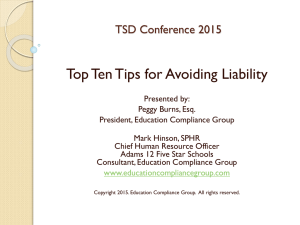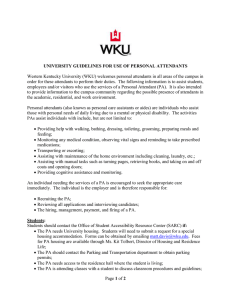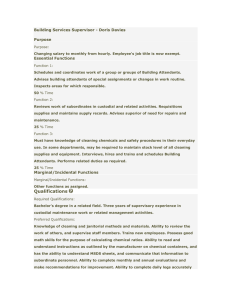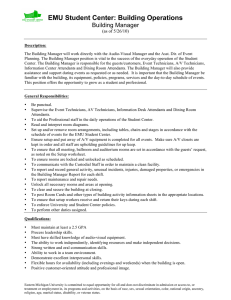Room Attendants
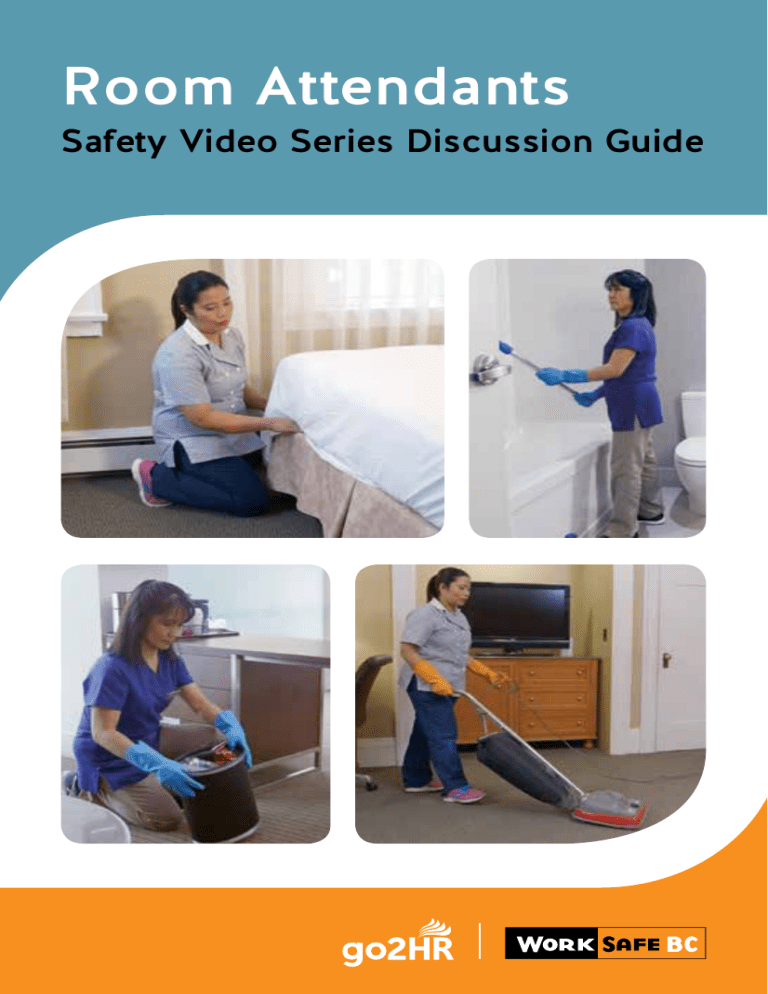
Room Attendants
Safety Video Series Discussion Guide
Contents
Acknowledgments . . . . . . . . . . . . . . . . . . . . . . . . . . 2
Introduction . . . . . . . . . . . . . . . . . . . . . . . . . . . . . . . 3
About the videos . . . . . . . . . . . . . . . . . . . . . . . . . . . . . . . . . . . .3
About this discussion guide . . . . . . . . . . . . . . . . . . . . . . . . . . .4
Video: Making Beds . . . . . . . . . . . . . . . . . . . . . . . . . 5
Video: Cleaning Bathrooms . . . . . . . . . . . . . . . . . . . 7
Video: Wringing . . . . . . . . . . . . . . . . . . . . . . . . . . . . 9
Video: High Dusting . . . . . . . . . . . . . . . . . . . . . . . . 10
Video: Emptying Cans . . . . . . . . . . . . . . . . . . . . . . 12
Video: Vacuuming . . . . . . . . . . . . . . . . . . . . . . . . . 13
Best practices for employers and supervisors . . . . 15
Training and orientation . . . . . . . . . . . . . . . . . . . . . . . . . . . . . .15
Communication . . . . . . . . . . . . . . . . . . . . . . . . . . . . . . . . . . . .16
Documentation . . . . . . . . . . . . . . . . . . . . . . . . . . . . . . . . . . . .16
WorkSafeBC publications and videos . . . . . . . . . . 17
WorkSafeBC prevention information line . . . . . . . . 18
Resources . . . . . . . . . . . . . . . . . . . . . . . . . . . . . . . 19
WorkSafeBC resources . . . . . . . . . . . . . . . . . . . . . . . . . . . . . .19
go2HR resources . . . . . . . . . . . . . . . . . . . . . . . . . . . . . . . . . . .19
Room Attendants: Safety Video Series Discussion Guide 1
Acknowledgments
These resources would not have been possible without the generous assistance of the B .C . accommodation industry .
WorkSafeBC would like to thank the following organizations and their representatives who participated in a working group formed to prepare these resources:
• Coast Hotels (B .C .)
• Delta Grand Okanagan Hotel (Kelowna)
• Delta Vancouver Suites (Vancouver)
• Fairmont Chateau Whistler (Whistler)
• Fairmont Waterfront (Vancouver)
• Harbour Towers Hotel & Suites (Victoria)
• Hilton Whistler Resort & Spa (Whistler)
• go2HR
• St . Eugene Golf Resort Casino (Cranbrook)
• Sylvia Hotel (Vancouver)
• The Plaza Hotel Kamloops (Kamloops)
• Treasure Cove Hotel (Prince George)
• Westin Bayshore (Vancouver)
2 Room Attendants: Safety Video Series Discussion Guide
Introduction
Over 50 percent of injuries in the accommodation industry involve room attendants (housekeeping staff) . The majority of these injuries are musculoskeletal injuries (MSIs) caused by improper lifting, overreaching, or awkward positioning .
As employers or supervisors, it’s essential that you identify potential hazards in your hotel and train your staff appropriately .
It’s important that room attendants work safely to prevent injury, especially to their shoulders, back, and knees . Training should explain the health hazards of improper lifting or awkward positioning, and give recommendations on what room attendants can do to perform their job safer .
This video series supports that training by demonstrating safe work procedures and providing instructions to prevent injuries to room attendants .
About the videos
This video series was filmed in a larger hotel environment, but the information and techniques in these videos are applicable to both small and large accommodations . These videos are appropriate for employers, supervisors, workers, members of joint occupational safety and health committees, and educators . They can be used for worker orientation, safety meetings, or incorporated into existing education and training programs .
The series consists of six videos that demonstrate proper and safe work procedures for common housekeeping activities, including ergonomically correct body postures when performing repetitive workplace tasks .
These videos are available on worksafebc.com
in both English and
Tagalog . There are optional subtitles in French, Spanish, Korean,
Punjabi, Vietnamese, Chinese simplified, and Chinese traditional .
Room Attendants: Safety Video Series Discussion Guide 3
About this discussion guide
This discussion guide contains discussion points and questions that will help viewers learn more about the proper techniques for making beds, cleaning bathrooms, wringing cloths, dusting, emptying waste cans, and vacuuming . A best practices section for employers and supervisors has also been included at the end of this guide .
After viewing each module, engage viewers in a discussion using some or all of the suggested questions .
4 Room Attendants: Safety Video Series Discussion Guide
Video: Making Beds
Making beds can be hard on your shoulders, back, and knees .
This video demonstrates safe work practices, and shows how proper body positioning and movement can prevent injuries .
What are some key safety messages in this video?
• Wear protective gloves .
• Visually check the bed for fluids and sharp objects .
• Detach bedding from all sides, working your way around the bed .
• To avoid tripping and overexertion, put used bedding directly into the bin or cart instead of on the floor .
• Remove gloves before making the bed .
Room Attendants: Safety Video Series Discussion Guide 5
What would happen if you always bent your back to make the bed? What are some tips for proper body positioning and movement when making beds?
• Always bend your knees, not your back . Kneel or squat .
(Reference graphic on the video or use poster to reinforce correct positioning .)
• Avoid lifting the mattress .
• Stuff pillows fully into cases instead of shaking .
• Avoid overreaching .
6 Room Attendants: Safety Video Series Discussion Guide
Video: Cleaning Bathrooms
Extending your shoulders and arms for long periods of time to wipe and clean can be tiring and can lead to strained muscles .
This video demonstrates safe work practices and how you can help prevent injuries while cleaning bathrooms .
What are some key safety messages in this video?
• Minimize awkward bending and overreaching by using tools with telescoping handles . (Ask workers to show how to extend handle .)
• Alternate hands when scrubbing .
• Always try to work at chest height .
• Ensure you have the right cleaning product for the job .
• Divide bathroom into sections to alternate high, medium, and low cleaning areas and body positions .
Room Attendants: Safety Video Series Discussion Guide 7
What can you do to keep from slipping while cleaning the tub?
• Use a damp cloth or rubber non-slip mat .
• Wear non-slip footwear .
• Use your non-scrubbing hand to balance yourself .
What if you can’t reach the area that needs to be cleaned?
What can you do about it? What shouldn’t you do?
• Use tools that have telescoping handles so you can adjust the length .
• Never balance on the edge of the tub .
• Stand in the tub to scrub the walls and back of the tub .
• Never overextend your reach .
• Don’t work for long periods of time reaching over your head .
• Don’t bend to do the work; squat instead .
What other safety tips or safe work procedures can you think of?
• Before walking into the bathroom and starting work, assess the area . Look for spills and other hazards . If the floor is wet, put down a towel .
• Take micro pauses:
– Return to an upright posture and let your arms hang loosely by your side .
– Let muscles rest by pausing for 5-10 seconds .
8 Room Attendants: Safety Video Series Discussion Guide
Video: Wringing
Forceful and repetitious twisting and bending of the wrist can cause wrist strain . This video demonstrates safe work practices and how you can help prevent injuries while wringing cloths .
What might happen if you don’t wring cloths properly?
What are some key safety messages in this video?
• Cloths should be large enough to be efficient, but small enough that you can squeeze out excess water with no more than two squeezing motions .
• Hold one hand above the other to produce a squeezing action .
• Start with your wrists flexed and, as you squeeze, bring them back to a neutral position . (Have workers demonstrate the proper wringing technique .)
Room Attendants: Safety Video Series Discussion Guide 9
Video: High Dusting
Reaching up while holding a duster for long periods of time requires awkward and fixed positions of the arms, shoulders, and neck . This task can lead to pain and stiffness in the neck, shoulders, and arms .
This video demonstrates safe work practices and how you can help prevent injuries while engaged in high dusting .
What if you can’t reach an area you need to dust? What are some key safety messages in this video?
• Extend your reach by using dusting tools with telescoping handles or a safe step stool .
• Never stand on chairs or other furniture .
• To improve your neck position and prevent dust from getting into your eyes, stand at an angle not directly under the dusting area .
• Work with your hands in front of your body, in the area between your shoulders, to minimize effort .
10 Room Attendants: Safety Video Series Discussion Guide
What other safety tips or procedures can you think of?
• Wear face/eye protection .
• Keep elbows close to the body to minimize overreaching .
Room Attendants: Safety Video Series Discussion Guide 11
Video: Emptying Cans
Garbage containers can be heavier than you think and may contain dangerous objects . Before moving them or handling the garbage, it’s important to check the weight of the can and examine its contents .
This video demonstrates safe work practices and how you can help prevent injuries when emptying waste cans .
What might happen if you don’t check the waste can before moving or emptying it? What are some key safety messages in this video?
• Always wear protective gloves .
• Tilt or pull the garbage can to check weight before moving it .
• Do a visual check of contents for broken glass or sharp points .
• Never push down on the garbage .
• Lift the can properly: use your knees and both hands to avoid bending your wrists .
12 Room Attendants: Safety Video Series Discussion Guide
Video: Vacuuming
Vacuuming presents risks to the arms and to the back from repeated twisting . This video demonstrates safe work practices and how you can help prevent injuries while vacuuming .
What might happen if you don’t have proper body positioning while vacuuming? What are some key safety messages in this video?
• Before you begin your work, ensure the vacuum is unplugged and then check for broken wheels or worn cords .
• When vacuuming, keep elbows at or near your sides to minimize shoulder movement .
• Adjust your grip on the vacuum so your hand is in line with your forearm .
Room Attendants: Safety Video Series Discussion Guide 13
• Walk the vacuum cleaner to reduce repetitive arm and shoulder motion .
• Avoid movements where your elbows are behind your body .
• Avoid overreaching by standing upright . Don’t bend forward .
• Move your legs to turn the vacuum, instead of twisting your back .
• Move light furniture out of the way to make a clear path for you and the vacuum .
• Always be aware of the power cord to avoid tripping .
What other safety tips or safe work procedures can you think of?
• Maintain a neutral spine while working comfortably .
• Keep arms close to your body to encourage neutral posture .
• Use both hands, one to hold the vacuum and the other to hold the cord so you don’t trip .
14 Room Attendants: Safety Video Series Discussion Guide
Best practices for employers and supervisors
It’s your responsibility as an employer to conduct a risk assessment to identify hazards, and then control them . Whenever possible, eliminate the hazard so there’s no risk of injury . When training your staff, follow the four steps below .
(1) Prepare — Provide a clear set of expectations for how work should be done . Give the employee health and safety resources, such as written safe work practices .
(2) Show — Describe how to do a specific task and then demonstrate it .
(3) Observe — Watch the employee do the task, and assess his or her understanding of the training . Provide feedback and correct any mistakes .
(4) Evaluate — Do spot checks and periodic evaluations to make sure the employee continues to follow the training .
Remember: “Inspect what you expect .”
Below are some additional best practices for promoting health and safety in your hotel:
Training and orientation
• Provide trainers with a health and safety reference manual that offers background information for orienting new room attendants .
• Assign new employees to a trained, designated trainer or pair them with an experienced employee who can mentor them .
• Encourage employees to ask questions during training .
• Use training tools, such as an occupational health and safety orientation checklist (with accompanying trainer information sheet), and a rights and responsibilities quiz .
Room Attendants: Safety Video Series Discussion Guide 15
Communication
• Respond promptly and appropriately when employees raise safety-related questions and concerns .
• Praise valued behaviours using positive reinforcement .
Use plain language and avoid jargon as much as possible .
• Consider an employee’s learning style when providing education, training, or task assignments . Ask open-ended
“what if” questions, and listen carefully to responses .
• Conduct reviews throughout the employee’s probationary period, and conduct a post-hire interview to confirm that he or she knows the basic safety information, such as the company’s health and safety representative .
Documentation
• Provide employees with documents, such as job-specific safety training, ergonomic tips, safe work practices for specific tasks, and a “spot the hazards” poster .
• Maintain orientation and training records . For example, have employees sign off on checklists and other training materials .
16 Room Attendants: Safety Video Series Discussion Guide
WorkSafeBC publications and videos
Many publications and videos are available for download on the WorkSafeBC website . The Occupational Health and Safety
Regulation and associated policies and guidelines, as well as the
Workers Compensation Act, are also available on worksafebc.com
.
Some publications and videos are available for purchase in print:
Phone: 604 .232 .9704
Toll-free phone: 1 .866 .319 .9704
Fax: 604 .232 .9703
Toll-free fax: 1 .888 .232 .9714
Online ordering: worksafebcstore.com
Room Attendants: Safety Video Series Discussion Guide 17
WorkSafeBC prevention information line
The WorkSafeBC prevention information line can answer your questions about workplace health and safety, worker and employer responsibilities, and can help you report a workplace accident or incident . The prevention information line accepts anonymous calls .
Phone 604 .276 .3100 in the Lower Mainland, or call
1 .888 .621 .7233 (621 .SAFE) toll-free in British Columbia .
To report after-hours and weekend accidents and emergencies, call 604 .723 .7711 in the Lower Mainland, or call 1 .866 .922 .4356
(WCB .HELP) toll-free in British Columbia .
18 Room Attendants: Safety Video Series Discussion Guide
Resources
WorkSafeBC resources
The following resources are available online at worksafebc.com
.
• Room Attendant infographic posters (for posting in staff lunch and break rooms)
• Ergonomic Tips for the Hospitality Industry pamphlet series
• Health and Safety for Hospitality Small Business Guid e
• 3 Steps to Effective Worker Education and Training
• A Clean Sweep: Safe Work Practices for Custodians (Infoflip and Web book)
go2HR resources
The following resources are available online at go2hr.ca/
OHSresources .
• Safety Sweep: An Employer’s Guide to Preventing Injuries to Room Attendants in BC Accommodations
• Keys to Injury Management: Return to Work Resources for
BC Accommodations
Room Attendants: Safety Video Series Discussion Guide 19
20 Room Attendants: Safety Video Series Discussion Guide
